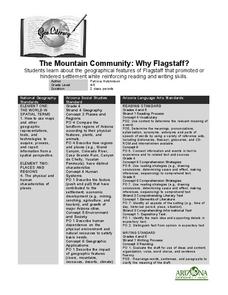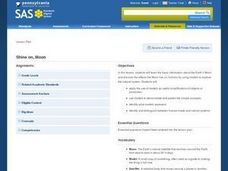Curated OER
Treaties
Second graders explore Canadian history by investigating the First Nations. In this Aboriginal treaty lesson, 2nd graders identify the specific agreements made between European settlers and Aboriginals which caused the formation of...
Curated OER
The Birth of a Rocky Mountain City and Railroad: Georgetown and the Loop Railroad
Students explore the evolution of a town. For this social studies lesson, students discuss why Georgetown and the Georgetown Loop Railroad were developed and discuss life as a prospector. Students write a letter explaining what life is...
Curated OER
Clay Hill Animal Sampling
Students create animal print casts from molds in the classroom. They use the cast patterns to identify animal prints on a field trip in which they locate animal tracks, identify the location with GPS and create field casts of the...
Curated OER
Treaties
Third graders explore Canadian history by participating in a role-playing activity. For this First Nation treaties lesson, 3rd graders identify the difficulties the Aboriginals faced when dealing with early European settlers. Students...
Curated OER
Simple Machines
Young scholars research simple machines. In this simple machines lesson, students explore the many types of simple machines such as the lever, pulley, and screw. Young scholars discover simple machines in the classroom.
Curated OER
Dogfighting Hurts Animals
Students discuss dogfights and relate caring for a baby to caring for their animal. In this dogfighting lesson, students view video about dogs forced to fight and relate to parenting skills. Students become familiar with ways to help...
Curated OER
Weather in the USA
Students identify the different types of weather conditions that occur in the United States. They discover how to adapt to weather and explain forecast and warning signals.
Curated OER
The Mountain Community: Why Flagstaff?
Students identify geographical features that hindered or promoted settlement in the city of Flagstaff, Arizona. In this settlement lesson plan, students write a summary of what they learned and identify geographical features on a map.
Curated OER
Take Me to the River
Students learn about a different way of life. In this river and dams lesson plan, students discuss the Hoover Dam. Students then view pictures of the Hoover Dam, discuss the impact of dams, and compare life before and after building a...
Pennsylvania Department of Education
Wind and Water Wheels
Students identify wind and water as natural resources that create energy. In this natural resources and energy use lesson, students work in groups to construct a pinwheel, then explore the effects of wind and water on the pinwheel....
Curated OER
How Does Ancestry Affect Folklore?
Students break into groups of 4 or 5 and choose an option to demonstrate a different cultural perspective in a fairy tale or other folklore that they are familiar. Possible choices are: PowerPoint presentation, video, digital...
Curated OER
Skimming Exercise
In this skimming exercise learning exercise, students quickly read a passage about reverse culture shock to find main ideas. Students have a short time period to read the text and identify the main ideas.
Curated OER
Jacksonian Democracy
Students determine how technological advancements have formed history. In this Jacksonian democracy lesson, students research innovations of the era and then compare them to the technological innovations of today. Students also debate...
Curated OER
A River Through Time
Learners explore how construction of a dam on the Gila River affected the lifestyle of Pima Indians. In this social studies lesson, students locate the Gila River and the Coolidge Dam. Learners record dates on a timeline and discuss how...
Curated OER
Earth Pockets
Students identify the Earth's natural resources. In this Earth science lesson, students read the book The Great Kapok Tree and discuss types of natural resources. Students use categories such as wood, paper, and trees and list items that...
Curated OER
Thank You For the Food We Eat
Young scholars explore where our food comes from. In this science instructional activity, students discuss how much of our food comes from animals. Young scholars construct a mobile.
Curated OER
The Conscription Crises
Students explore roles played by Canada's prime ministers The Right Honorable Sir Wilfrid Laurier and The Right Honorable iam Lyon Mackenzie King with regards to the conscription crises of World War I and World War II.
Curated OER
Frog Metamorphosis
Students play 20 Questions with animal characteristics and then view an animation of how a tadpole changes into a frog. They consider the importance of camouflage to frogs and write out the story of a frog from tadpole to adult.
Curated OER
What Is Culture
Fourth graders investigate the concept of culture. They look into the influences that shape culture and how it effects people and regional areas. Students answer the question of why it is important to study culture to have a better...
Curated OER
Understanding the Problems of World Hunger
High schoolers explore the issue of world hunger. They examine hunger on a personal level and explore what it means to be hungry or starving. They discuss the causes of hunger and the effects of hunger on nations.
Curated OER
Temperate Forests vs. Wetlands
Students compare and contrast the temperate forest and wetlands by researching them in groups. For this forest lesson plan, students identify the economic, ecological, and social benefits of each.
Curated OER
Freshwater Macroinvertebrates
Students identify and count Macroinvertebrates at a Hydrology website. For this macroinvertebrates lesson students collect, sort and identify Macroinvertebrates.
Curated OER
Shine On, Moon
Students explore space science by conducting an experiment in class. In this Moon lesson, students define a list of space science vocabulary and read the book The Moon. Students utilize shoeboxes and string to conduct a sunlight...
Curated OER
What's In Your Grocery Bag?
Students explore the global implications of consumer decisions when purchasing groceries. They examine labels of food products and discuss the wording on the labels. They calculate food miles of how far each ingredient in foods has...

























